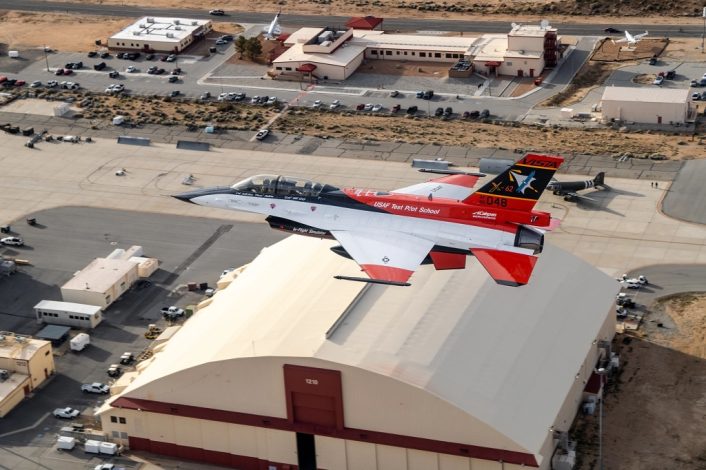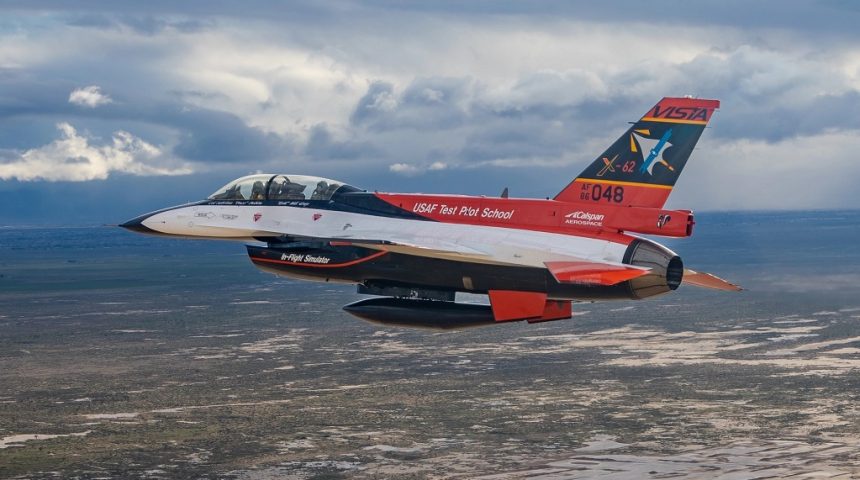While safety pilots were onboard at all times, the AI agent successfully demonstrated it could safely conduct AI versus human within-visual-range engagements.
The U.S. Air Force Test Pilot School and the Defense Advanced Research Projects Agency just announced that last year the X-62 VISTA was successfully flown by an Artificial Intelligence agent during a simulated dogfight against a human pilot on an F-16. The breakthrough, for which the team has been nominated as finalist for the 2023 Robert J. Collier Trophy, is part of DARPA’s Air Combat Evolution (ACE) program.
“The potential for autonomous air-to-air combat has been imaginable for decades, but the reality has remained a distant dream up until now,” said Secretary of the Air Force Frank Kendall. “In 2023, the X-62A broke one of the most significant barriers in combat aviation. This is a transformational moment, all made possible by breakthrough accomplishments of the X-62A ACE team”.
The press release did not disclose when the testing happened, however, since it mentioned the teams went from the initial installation of live AI agents into the X-62A’s systems to the demonstration in less than a calendar year, it’s possible it happened between summer and fall 2023. The Air Force acknowledged that the first flights of the X-62 controlled by AI agents were performed in December 2022.
The testing happened in the airspace above Edwards Air Force Base, California. Initial flight safety was built up first using defensive maneuvers, according to the info released, before switching to offensive high-aspect nose-to-nose engagements where the dogfighting aircraft got as close as 2,000 feet at 1,200 miles per hour. In total, the team made over 100,000 lines of flight-critical software changes across 21 test flights.
The X-62A is flown with safety pilots onboard with the independent ability to disengage the AI agent should something go sideways. However, the test pilots did not have to activate the safety switch at any point during the engagements over Edwards AFB, said the Air Force.
The AI versus human within-visual-range engagement, otherwise known as a dogfight, is a highly complex scenario that, according to the service, the X-62A utilized to successfully prove using non-deterministic artificial intelligence safely is possible within aerospace. While performing Basic Fighter Maneuvers against a manned aircraft was the primary testing scenario, it was not the end goal.
“It’s very easy to look at the X-62A ACE program and see it as under autonomous control, it can dogfight, but that misses the point,” said Bill Gray, the Test Pilot School’s chief test pilot. “Dogfighting was the problem to solve so we could start testing autonomous artificial intelligence systems in the air. Every lesson we’re learning applies to every task you could give to an autonomous system”.
The first-ever use of machine-learning-based autonomy in flight-critical systems will serve as a foundation for future aerospace AI advances that are both safer and more reliable in both commercial and defense applications. The lessons learned will be advanced onto future programs of record, while the X-62 will continue to serve a variety of customers for research, while providing key academic lessons.
The X-62 Variable Stability In-Flight Simulator Test Aircraft
The NF-16 VISTA started life as a F-16D Block 30 which later received numerous upgrades and modifications, flying for the first time in the new configuration in 1992, and became an important part of the Test Pilot School curriculum. In 2021 it was redesignated as the X-62A in preparation for its participation in Skyborg autonomous flight tests with the Air Force Research Laboratory.
The aircraft was upgraded to fully replace the VISTA Simulation System and add a new system called the System for Autonomous Control of Simulation (SACS) to support autonomy testing, prompting the redesignation as an X-plane. The central control stick connected to the simulation system, in addition to the F-16’s peculiar side stick, was left installed on the aircraft.
Artificial Intelligence agents successfully piloted the X-62A for the first time during 12 flights between December 1 and 16, 2022. The test campaign involved two AI agents, the AFRL’s Autonomous Air Combat Operations and DARPA’s Air Combat Evolution, each performing in different roles.
In fact, while the AACO’s AI agents performed one-on-one beyond-visual-range (BVR) engagements against a simulated adversary, the ACE’s AI agents performed within-visual-range maneuvering, also known as “dogfighting”, against constructive AI red-team agents. Both teams’ AI agents executed autonomous tactical maneuvering while maintaining real-world airspace boundaries and optimizing aircraft performance.

The Air Combat Evolution program
DARPA’s ACE program aims to develop trusted, scalable, human-level, AI-driven autonomy for air combat by using human-machine collaborative dogfighting as its challenge problem. As we reported in 2020, the ACE program’s AlphaDogfight Trials pitted AI agents against each other flying simulated F-16s in a virtual dogfighting competition that culminated with the winning AI defeating an experienced F-16 fighter pilot flying in a simulator.
The AI vs human dogfight was the final event of the three-day competition, which saw eight different AI programs battling each other in different scenarios. Each participating company developed its AI program and, using machine learning, they put their programs through thousands of simulations to gain experience.
The winning AI agent emerged with an aggressive behavior which went for very precise high aspect gun kills, often at the first merge at the beginning of the fight. The agent was capitalizing on the safety limitations, imposed through the Air Force Instruction (AFI) publications which the human pilot was adhering to during the simulator flight.
Other than flying more precisely and at the limits of safety regulations, the AI also had quicker reactions thanks to the computer’s faster OODA loop (Observe, Orient, Decide and Act). This resulted in the AI getting a shot as soon as it could, while the human pilot tried to maneuver for a follow-on/rear shot and did not attempt to get a face-shot or a shot of opportunity, even when he had a chance, which ultimately made the difference.









